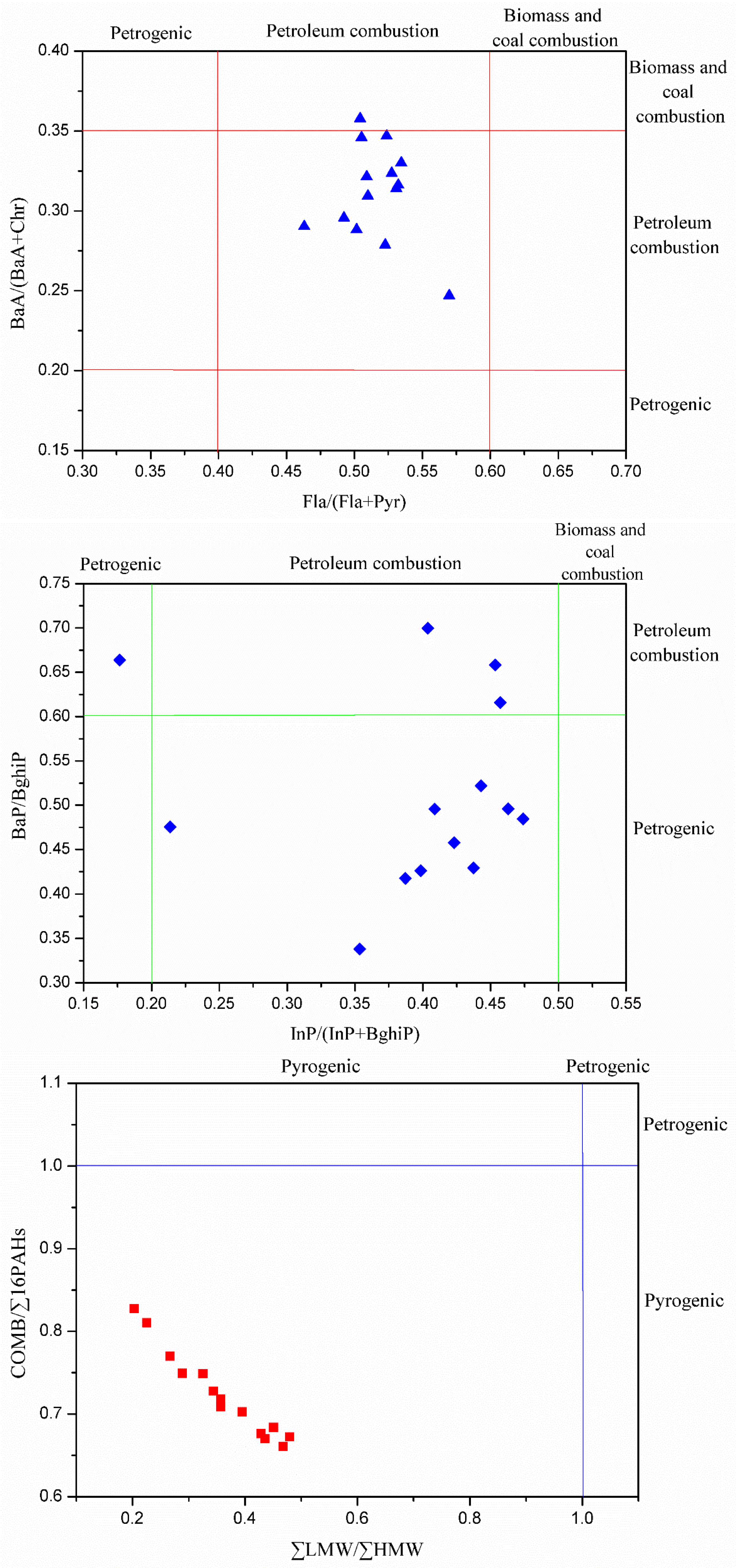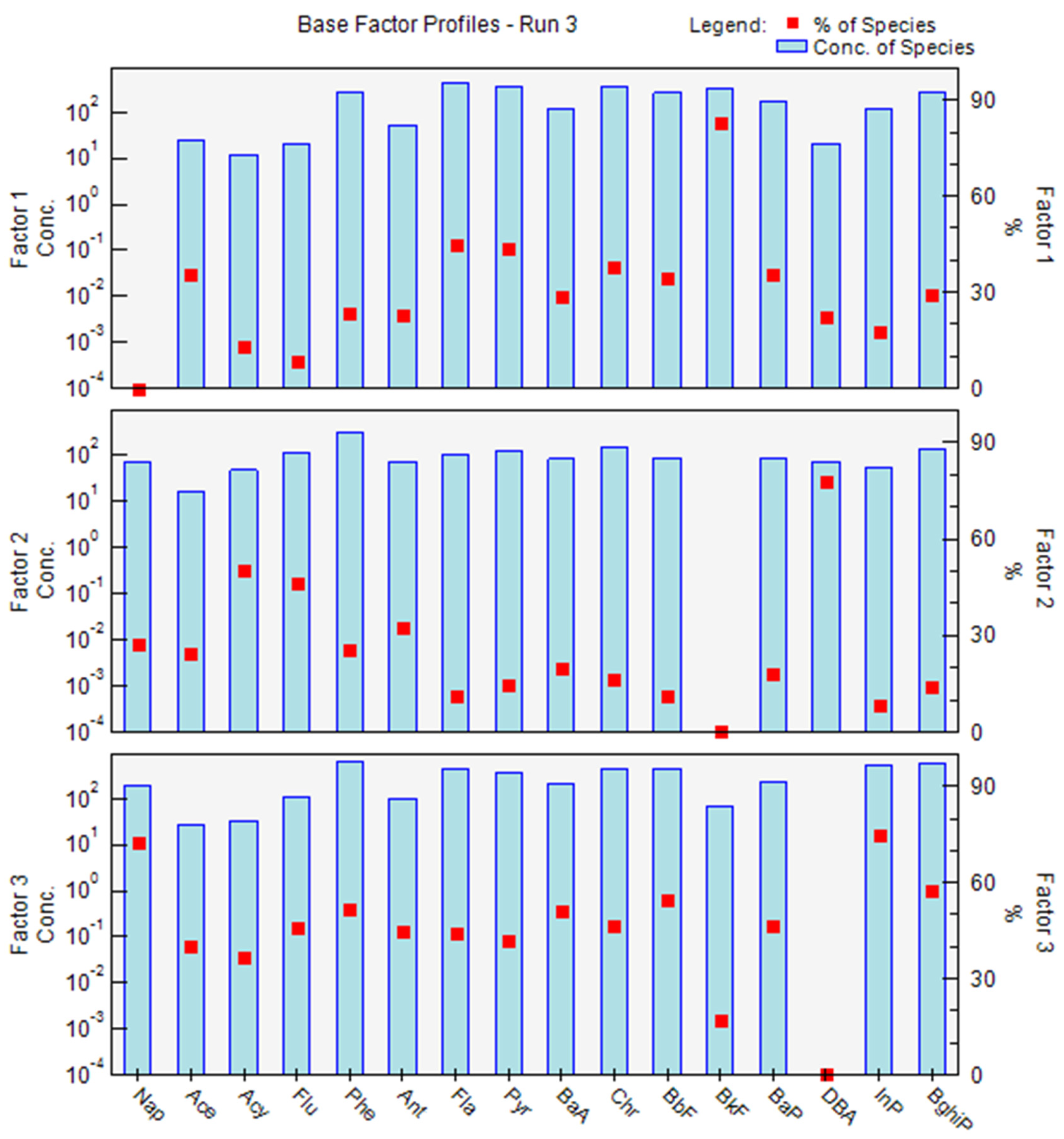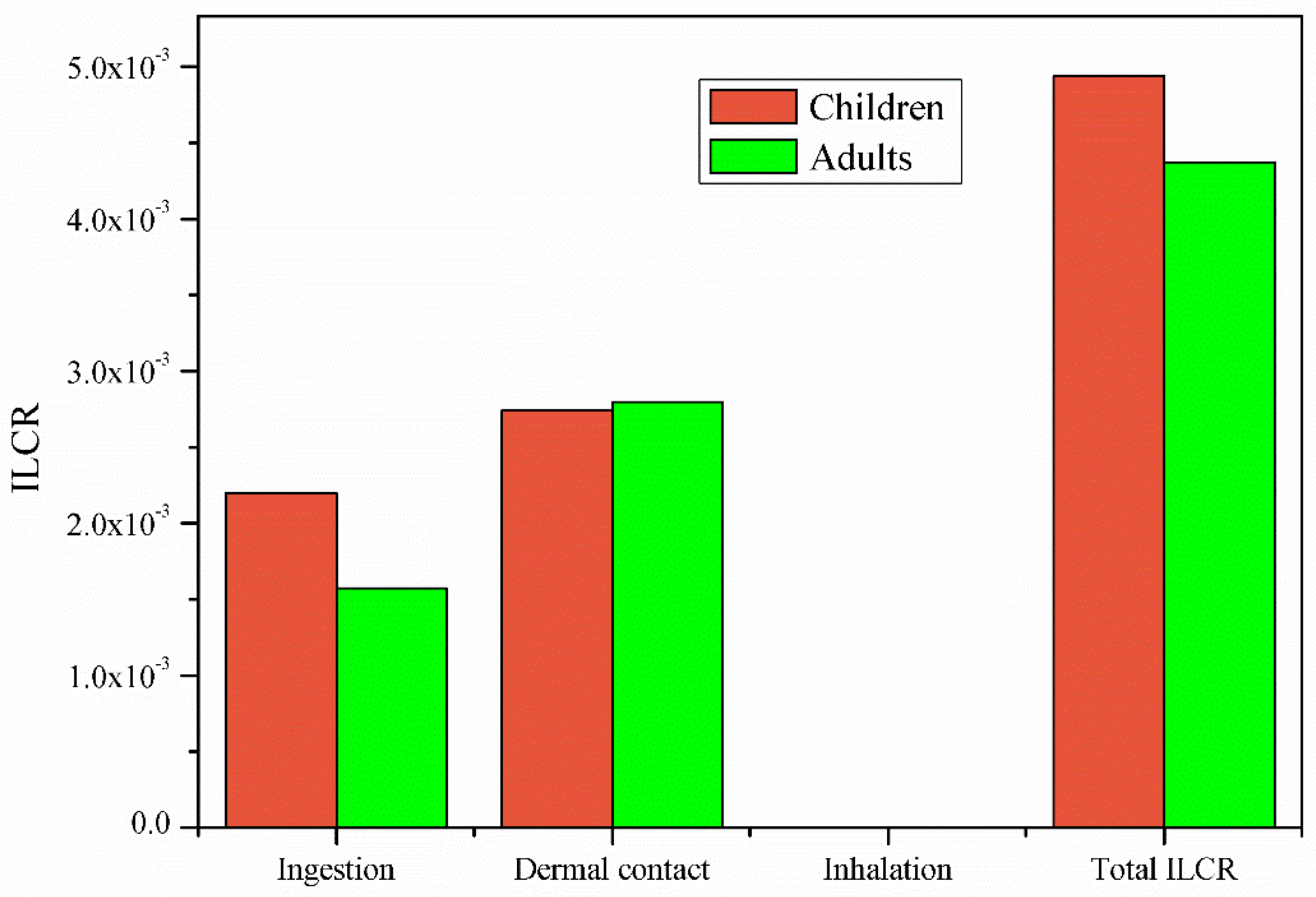Pollution Characteristics and Carcinogenic Risk Assessment of PAHs in Car Dust Collected from Commercial Car Wash in Changchun, Northeast China
Abstract
:1. Introduction
2. Methods and Materials
2.1. Sampling and Pretreatment
2.2. Chemical Analysis
2.3. Carcinogenic Risk Assessment of PAHs through Dusts Exposure
2.4. Statistical Analysis
3. Results and Discussion
3.1. PAHs Content in Car Dust and Compared to Other Studies
3.2. PAHs’ Source Identification
3.2.1. Correlation Analysis among PAHs, BC and TC
3.2.2. Diagnostic Ratios
3.2.3. Principal Component Analysis
3.2.4. Positive Matrix Factorization
3.3. Potential Carcinogenic Risks of PAHs from Car Dust
4. Conclusions
Supplementary Materials
Author Contributions
Funding
Data Availability Statement
Conflicts of Interest
References
- Ali, N.; Ali, L.; Mehdi, T.; Dirtu, A.C.; Al-Shammari, F.; Neels, H.; Covaci, A. Levels and profiles of organochlorines and flame retardants in car and house dust from Kuwait and Pakistan: Implication for human exposure via dust ingestion. Environ. Int. 2013, 55, 62–70. [Google Scholar] [CrossRef] [PubMed]
- Besis, A.; Christia, C.; Poma, G.; Covaci, A.; Samara, C. Legacy and novel brominated flame retardants in interior car dust—Implications for human exposure. Environ. Pollut. 2017, 230, 871–881. [Google Scholar] [CrossRef] [PubMed]
- Jin, M.; Zhang, S.; He, J.; Lu, Z.; Zhou, S.; Ye, N. Polybrominated diphenyl ethers from automobile microenvironment: Occurrence, sources, and exposure assessment. Sci. Total Environ. 2021, 781, 146658. [Google Scholar] [CrossRef]
- Liu, S.; Zhan, C.; Zhang, J.; Liu, H.; Xiao, Y.; Zhang, L.; Guo, J.; Liu, X.; Xing, X.; Cao, J. Polycyclic aromatic hydrocarbons in railway stations dust of the mega traffic hub city, central China: Human health risk and relationship with black carbon. Ecotoxicol. Environ. Saf. 2020, 205, 111155. [Google Scholar] [CrossRef]
- Velazquez-Gomez, M.; Hurtado-Fernandez, E.; Lacorte, S. Differential occurrence, profiles and uptake of dust contami-nants in the Barcelona urban area. Sci. Total Environ. 2019, 648, 1354–1370. [Google Scholar] [CrossRef]
- Wang, C.; Li, Y.; Liu, J.; Xiang, L.; Shi, J.; Yang, Z. Characteristics of PAHs adsorbed on street dust and the correlation with specific surface area and TOC. Environ. Monit. Assess. 2010, 169, 661–670. [Google Scholar] [CrossRef]
- Wu, Y.; Zhang, N.; Wang, Y.; Ren, Y.; Yuan, Z.; Li, N. Concentrations of polycyclic aromatic hydrocarbons in street dust from bus stops in Qingyang city: Estimates of lifetime cancer risk and sources of exposure for daily commuters in Northwest China. Environ. Pollut. 2020, 266, 115222. [Google Scholar] [CrossRef] [PubMed]
- Al-Harbi, M.; Alhajri, I.; Whalen, J.K. Health risks associated with the polycyclic aromatic hydrocarbons in indoor dust collected from houses in Kuwait. Environ. Pollut. 2020, 266, 115054. [Google Scholar] [CrossRef]
- Anh, H.Q.; Minh, T.B.; Tran, T.M.; Takahashi, S. Road dust contamination by polycyclic aromatic hydrocarbons and their methylated derivatives in northern Vietnam: Concentrations, profiles, emission sources, and risk assessment. Environ. Pollut. 2019, 254, 113073. [Google Scholar] [CrossRef]
- Lim, H.; Sadiktsis, I.; de Oliveira Galvao, M.F.; Westerholm, R.; Dreij, K. Polycyclic aromatic compounds in particulate matter and indoor dust at preschools in Stockholm, Sweden: Occurrence, sources and genotoxic potential in vitro. Sci. Total. Environ. 2021, 755 Pt 1, 142709. [Google Scholar] [CrossRef]
- Jin, M.; Ye, N.; Lu, Z.; Zhang, S.; Zhou, S.; He, J. Pollution characteristics and source identification of PBDEs in public transport microenvironments. Sci. Total Environ. 2022, 820, 153159. [Google Scholar] [CrossRef] [PubMed]
- Velázquez-Gómez, M.; Lacorte, S. Nasal lavages as a tool for monitoring exposure to organic pollutants. Environ. Res. 2019, 178, 108726. [Google Scholar] [CrossRef] [PubMed]
- Wang, Z.; Wang, S.; Nie, J.; Wang, Y.; Liu, Y. Assessment of polycyclic aromatic hydrocarbons in indoor dust from varying categories of rooms in Changchun city, northeast China. Environ. Geochem. Health 2017, 39, 15–27. [Google Scholar] [CrossRef] [PubMed]
- Romagnoli, P.; Balducci, C.; Cecinato, A.; L’Episcopo, N.; Gariazzo, C.; Gatto, M.P.; Gordiani, A.; Gherardi, M. Fine particulate-bound polycyclic aromatic hydrocarbons in vehicles in Rome, Italy. Environ. Sci. Pollut. Res. 2017, 24, 3493–3505. [Google Scholar] [CrossRef]
- Cui, X.; Xiang, P.; He, R.-W.; Juhasz, A.; Ma, L.Q. Advances in in vitro methods to evaluate oral bioaccessibility of PAHs and PBDEs in environmental matrices. Chemosphere 2016, 150, 378–389. [Google Scholar] [CrossRef]
- Gao, P.; Liu, S.; Feng, Y.; Lin, N.; Lu, B.; Zhang, Z.; Cui, F.; Xing, B.; Hammond, S.K. Concentrations of polycyclic aromatic hydrocarbons in resuspendable fraction of settled bus dust and its im-plications for human exposure. Environ. Pollut. 2015, 198, 1–7. [Google Scholar] [CrossRef]
- Brandsma, S.H.; de Boer, J.; van Velzen, M.J.; Leonards, P.E. Organophosphorus flame retardants (PFRs) and plasticizers in house and car dust and the influence of electronic equipment. Chemosphere 2014, 116, 3–9. [Google Scholar] [CrossRef]
- Ali, N.; Kadi, M.W.; Ali Albar, H.M.S.; Rashid, M.I.; Chandrasekaran, S.; Summan, A.S.; de Wit, C.A.; Malarvannan, G. Semi-Volatile Organic Compounds in Car Dust: A Pilot Study in Jeddah, Saudi Arabia. Int. J. Environ. Res. Public Health 2021, 18, 4803. [Google Scholar] [CrossRef]
- Ali, N.; Ismail, I.M.I.; Khoder, M.; Shamy, M.; Alghamdi, M.; Costa, M.; Ali, L.N.; Wang, W.; Eqani, S.A.M.A.S. Polycyclic aromatic hydrocarbons (PAHs) in indoor dust samples from Cities of Jeddah and Kuwait: Levels, sources and non-dietary human exposure. Sci. Total Environ. 2016, 573, 1607–1614. [Google Scholar] [CrossRef]
- Stamatelopoulou, A.; Dasopoulou, M.; Bairachtari, K.; Karavoltsos, S.; Sakellari, K.; Maggos, T. Contamination and Potential Risk Assessment of Polycyclic Aromatic Hydrocarbons (PAHs) and Heavy Metals in House Settled Dust Collected from Residences of Young Children. Appl. Sci. 2021, 11, 1479. [Google Scholar] [CrossRef]
- Živančev, J.; Antić, I.; Buljovčić, M.; Đurišić-Mladenović, N. A case study on the occurrence of polycyclic aromatic hydrocarbons in indoor dust of Serbian households: Distribution, source apportionment and health risk assessment. Chemosphere 2022, 295, 133856. [Google Scholar] [CrossRef]
- Yusuf, R.O.; Odediran, E.T.; Adeniran, J.A.; Adesina, O.A. Polycyclic aromatic hydrocarbons in road dusts of a densely populated African city: Spatial and seasonal distribution, source, and risk assessment. Environ. Sci. Pollut. Res. 2022, 29, 44970–44985. [Google Scholar] [CrossRef]
- Al-Harbi, M.; Al-Enzi, E.; Al-Mutairi, H.; Whalen, J.K. Human health risks from brominated flame retardants and polycyclic aromatic hydrocarbons in indoor dust. Chemosphere 2021, 282, 131005. [Google Scholar] [CrossRef] [PubMed]
- Wang, H.; Chen, Z.; Walker, T.R.; Wang, Y.; Luo, Q.; Wu, H.; Wang, X. Characterization, source apportionment and risk assessment of PAHs in urban surface dust in Shenyang city, China. Environ. Geochem. Health 2021, 44, 3639–3654. [Google Scholar] [CrossRef] [PubMed]
- Aminiyan, M.M.; Kalantzi, O.-I.; Etesami, H.; Khamoshi, S.E.; Begloo, R.H.; Aminiyan, F.M. Occurrence and source apportionment of polycyclic aromatic hydrocarbons (PAHs) in dust of an emerging industrial city in Iran: Implications for human health. Environ. Sci. Pollut. Res. 2021, 28, 63359–63376. [Google Scholar] [CrossRef]
- Shukla, S.; Khan, R.; Bhattacharya, P.; Devanesan, S.; AlSalhi, M.S. Concentration, source apportionment and potential carcinogenic risks of polycyclic aromatic hydrocarbons (PAHs) in roadside soils. Chemosphere 2022, 292, 133413. [Google Scholar] [CrossRef]
- Reizer, E.; Viskolcz, B.; Fiser, B. Formation and growth mechanisms of polycyclic aromatic hydrocarbons: A mini-review. Chemosphere 2022, 291, 132793. [Google Scholar] [CrossRef] [PubMed]
- Huang, Q.; Zhao, T.; Qi, A.; Gao, H.; Zhang, W.; Duan, S.; Wang, P.; Wang, Y.; Zhang, X.; Wang, W.; et al. Comparison of indoor and outdoor polycyclic aromatic hydrocarbons from multiple urban residences in Northern China: Coastal versus inland area. Build. Environ. 2022, 212, 108800. [Google Scholar] [CrossRef]
- Liu, Y.; Liu, G.; Yousaf, B.; Zhang, J.; Zhou, L. Carbon fractionation and stable carbon isotopic fingerprint of road dusts near coal power plant with emphases on coal-related source apportionment. Ecotoxicol. Environ. Saf. 2020, 202, 110888. [Google Scholar] [CrossRef]
- Xu, B.; Liu, F.; Alfaro, D.; Jin, Z.; Liu, Y.; Liu, Y.; Zhou, Z.; Zhang, J. Polycyclic aromatic hydrocarbons in fine road dust from a coal-utilization city: Spatial distribution, source diagnosis and risk assessment. Chemosphere 2022, 286, 131555. [Google Scholar] [CrossRef]
- Jiang, Y.; Hu, X.; Yves, U.J.; Zhan, H.; Wu, Y. Status, source and health risk assessment of polycyclic aromatic hydrocarbons in street dust of an industrial city, NW China. Ecotoxicol. Environ. Saf. 2014, 106, 11–18. [Google Scholar] [CrossRef] [PubMed]
- Demir, T.; Karakaş, D.; Yenisoy-Karakaş, S. Source identification of exhaust and non-exhaust traffic emissions through the elemental carbon fractions and Positive Matrix Factorization method. Environ. Res. 2022, 204, 112399. [Google Scholar] [CrossRef] [PubMed]
- Škrbić, B.D.; Antić, I.; Živančev, J.; Vágvölgyi, C. Comprehensive characterization of PAHs profile in Serbian soils for conventional and organic production: Potential sources and risk assessment. Environ. Geochem. Health 2021, 43, 4201–4218. [Google Scholar] [CrossRef] [PubMed]
- Wang, M.; Jia, S.; Lee, S.H.; Chow, A.; Fang, M. Polycyclic aromatic hydrocarbons (PAHs) in indoor environments are still imposing carcinogenic risk. J. Hazard. Mater. 2021, 409, 124531. [Google Scholar] [CrossRef] [PubMed]
- Tian, Y.; Liu, X.; Huo, R.; Shi, Z.; Sun, Y.; Feng, Y.; Harrison, R.M. Organic compound source profiles of PM2.5 from traffic emissions, coal combustion, industrial processes and dust. Chemosphere 2021, 278, 130429. [Google Scholar] [CrossRef]
- Sun, J.; Yu, J.; Shen, Z.; Niu, X.; Wang, D.; Wang, X.; Xu, H.; Chuang, H.-C.; Cao, J.; Ho, K.-F. Oxidative stress–inducing effects of various urban PM2.5 road dust on human lung epithelial cells among 10 Chinese megacities. Ecotoxicol. Environ. Saf. 2021, 224, 112680. [Google Scholar] [CrossRef]
- Alghamdi, M.A.; Hassan, S.K.; Alzahrani, N.A.; Al Sharif, M.Y.; Khoder, M.I. Classroom Dust-Bound Polycyclic Aromatic Hydrocarbons in Jeddah Primary Schools, Saudi Arabia: Level, Characteristics and Health Risk Assessment. Int. J. Environ. Res. Public Health 2020, 17, 2779. [Google Scholar] [CrossRef] [Green Version]
- Fang, X.; Wu, L.; Zhang, Q.; Zhang, J.; Wang, A.; Zhang, Y.; Zhao, J.; Mao, H. Characteristics, emissions and source identifications of particle polycyclic aromatic hydrocarbons from traffic emissions using tunnel measurement. Transp. Res. Part D Transp. Environ. 2019, 67, 674–684. [Google Scholar] [CrossRef]
- Luo, K.; Zeng, D.; Kang, Y.; Lin, X.; Sun, N.; Li, C.; Zhu, M.; Chen, Z.; Man, Y.B.; Li, H. Dermal bioaccessibility and absorption of polycyclic aromatic hydrocarbons (PAHs) in indoor dust and its im-plication in risk assessment. Environ. Pollut. 2020, 264, 114829. [Google Scholar] [CrossRef]
- Kang, Y.; Zeng, D.; Man, Y.B.; Liu, J.; Yang, Y.; Li, S.; Situ, K.; Xiong, W.; Zeng, L.; Zhang, Q.; et al. Comparison of sorption kinetics of PAHs by sorptive sinks and caco-2 cell and the correlation between bio-accessibility and bioavailability of PAHs in indoor dust. Sci. Total Environ. 2018, 645, 170–178. [Google Scholar] [CrossRef]
- Williams, S.E.; Mahler, B.J.; van Metre, P.C. Cancer Risk from Incidental Ingestion Exposures to PAHs Associated with Coal-Tar-Sealed Pavement. Environ. Sci. Technol. 2013, 47, 1101–1109. [Google Scholar] [CrossRef] [PubMed]
- Nduka, J.K.; Amuka, J.P.O.; Onwuka, J.C.; Udowelle, N.A.; Orisakwe, O.E. Human health risk assessment of lead, manganese and copper from scrapped car paint dust from automobile workshops in Nigeria. Environ. Sci. Pollut. Res. 2016, 23, 20341–20349. [Google Scholar] [CrossRef] [PubMed]
- Nagpure, A.S.; Gurjar, B.; Kumar, V.; Kumar, P. Estimation of exhaust and non-exhaust gaseous, particulate matter and air toxics emissions from on-road vehicles in Delhi. Atmos. Environ. 2016, 127, 118–124. [Google Scholar] [CrossRef]



| Statistic | Min | Max | Mean | SD | CV% |
|---|---|---|---|---|---|
| Black carbon (g kg−1) | 5.74 | 63.07 | 26.55 | 12.78 | 48.12 |
| Total carbon (g kg−1) | 65.88 | 177.61 | 128.97 | 30.45 | 23.61 |
| Naphthalene (ng g−1) | 68.94 | 1066.04 | 386.15 | 321.08 | 83.15 |
| Acenaphthene (ng g−1) | 32.31 | 200.07 | 72.28 | 47.24 | 65.36 |
| Acenaphthylene (ng g−1) | 66.34 | 163.83 | 93.92 | 33.16 | 35.31 |
| Fluorene (ng g−1) | 140.81 | 461.07 | 250.37 | 124.81 | 49.85 |
| Phenanthrene (ng g−1) | 469.92 | 3218.09 | 1311.79 | 875.10 | 66.71 |
| Anthracene (ng g−1) | 107.01 | 435.25 | 232.66 | 114.91 | 49.39 |
| Fluoranthene (ng g−1) | 254.43 | 2633.51 | 997.71 | 730.08 | 73.18 |
| Pyrene (ng g−1) | 227.84 | 2404.42 | 906.20 | 609.46 | 67.25 |
| Benzo[a]anthracene (ng g−1) | 135.61 | 1055.09 | 429.65 | 256.51 | 59.70 |
| Chrysene (ng g−1) | 290.42 | 2729.97 | 972.96 | 654.09 | 67.23 |
| Benzo[b]fluoranthene (ng g−1) | 180.07 | 2824.73 | 895.09 | 712.05 | 79.55 |
| Benzo[k]fluoranthene (ng g−1) | 48.97 | 1096.48 | 412.49 | 319.92 | 77.56 |
| Benzo[a]pyrene (ng g−1) | 151.81 | 1087.18 | 495.36 | 309.78 | 62.54 |
| Dibenzo[ah]anthracene (ng g−1) | 39.04 | 454.84 | 129.45 | 121.10 | 93.56 |
| Indeno[123-cd]pyrene (ng g−1) | 74.78 | 1794.49 | 681.34 | 490.78 | 72.03 |
| Benzo[ghi]perylene (ng g−1) | 242.66 | 2307.03 | 1030.36 | 677.85 | 65.79 |
| ∑16PAHs (ng g−1) | 2940.03 | 23174.51 | 9297.79 | 5855.89 | 62.98 |
| ∑7carPAHs (ng g−1) | 1210.59 | 10,945.87 | 4016.35 | 2656.95 | 66.15 |
| ∑LMW PAHs (ng g−1) | 935.32 | 4883.68 | 2347.18 | 1415.01 | 60.29 |
| ∑HMW PAHs (ng g−1) | 2002.84 | 18,290.82 | 6950.61 | 4600.86 | 66.19 |
| 2 rings (ng g−1) | 68.94 | 1066.04 | 386.15 | 321.08 | 83.15 |
| 3 rings (ng g−1) | 839.72 | 4384.08 | 1961.03 | 1158.53 | 59.08 |
| 4 rings (ng g−1) | 911.61 | 8822.99 | 3306.52 | 2214.93 | 66.99 |
| 5 rings (ng g−1) | 542.13 | 5366.32 | 1932.39 | 1314.07 | 68.00 |
| 6 rings (ng g−1) | 423.07 | 4101.52 | 1711.70 | 1146.38 | 66.97 |
| City | Sample (n) | N of PAHs | Range | Mean | Reference |
|---|---|---|---|---|---|
| Changchun, China | Car dust (14) | 16 | 2940.03–23,174.51 | 9297.79 | This study |
| Jeddah, Saudi Arabia | Car dust (15) | 16 | -- | 2762 | [18] |
| Barcelona | Car dust (14) | 16 | -- | 32,512 a | [5] |
| Kuwait | Non-smoking car dust (22) | 16 | 516–1554 | 945 | [23] |
| Kuwait | Smoking car dust (18) | 16 | 1082–3086 | 1908 | [23] |
| Qingyang, China | Bus stop dust (126) | 16 | 800–18,300 | 4100 | [7] |
| Wuhan, China | Railway station dust (12) | 16 | 4170–10,400 | 5940 | [4] |
| Wuchang, China | Railway station dust (8) | 16 | 467–5740 | 2580 | [4] |
| Voivodina, Serbia | Indoor dust (47) | 16 | 140–8265 | 1825 | [21] |
| Shenyang, China | Urban dust (30) | 14 | 371.57–3300.04 | 1244.76 | [24] |
| Rafsanjan, Iran | Street dust (70) | 17 | 1380–1550 | 1443 | [25] |
| Lucknow, India | Roadside soil (10) | 15 | 478.94–8164.07 | 3748.23 | [26] |
| Rotated Component Matrix a | |||
|---|---|---|---|
| PAHs | PC 1 | PC 2 | PC 3 |
| Nap | 0.078 | 0.954 | −0.044 |
| Ace | 0.944 | 0.193 | −0.012 |
| Acy | 0.179 | 0.866 | 0.419 |
| Flu | 0.244 | 0.882 | 0.377 |
| Phe | 0.600 | 0.721 | 0.255 |
| Ant | 0.546 | 0.790 | 0.176 |
| Fla | 0.930 | 0.312 | 0.181 |
| Pyr | 0.872 | 0.390 | 0.284 |
| BaA | 0.663 | 0.614 | 0.363 |
| Chr | 0.790 | 0.455 | 0.394 |
| BbF | 0.749 | 0.436 | 0.426 |
| BkF | 0.880 | −0.102 | 0.277 |
| BaP | 0.831 | 0.488 | 0.081 |
| DBA | 0.280 | 0.295 | 0.889 |
| InP | 0.685 | 0.610 | 0.211 |
| BghiP | 0.649 | 0.716 | 0.239 |
| % variance | 45.81 | 36.64 | 12.33 |
Publisher’s Note: MDPI stays neutral with regard to jurisdictional claims in published maps and institutional affiliations. |
© 2022 by the authors. Licensee MDPI, Basel, Switzerland. This article is an open access article distributed under the terms and conditions of the Creative Commons Attribution (CC BY) license (https://creativecommons.org/licenses/by/4.0/).
Share and Cite
Yu, R.; Cui, Z.; Luo, N.; Yu, Y. Pollution Characteristics and Carcinogenic Risk Assessment of PAHs in Car Dust Collected from Commercial Car Wash in Changchun, Northeast China. Sustainability 2022, 14, 15013. https://doi.org/10.3390/su142215013
Yu R, Cui Z, Luo N, Yu Y. Pollution Characteristics and Carcinogenic Risk Assessment of PAHs in Car Dust Collected from Commercial Car Wash in Changchun, Northeast China. Sustainability. 2022; 14(22):15013. https://doi.org/10.3390/su142215013
Chicago/Turabian StyleYu, Rui, Zhengwu Cui, Nana Luo, and Yong Yu. 2022. "Pollution Characteristics and Carcinogenic Risk Assessment of PAHs in Car Dust Collected from Commercial Car Wash in Changchun, Northeast China" Sustainability 14, no. 22: 15013. https://doi.org/10.3390/su142215013





